EcoBuild 2014
The one thing you can say about EcoBuild is that it doesn't get any smaller. There's also a good argument to be made that it doesn't become any more relevant to the paving and hard-landscaping trades. It burbles along, year after year, with almost exactly the minimum threshold level of paving interest to make me think it's worth the train fare down to that London and the ride on the Toy Town train out to Docklands.
Having the interesting exhibitors scattered here there and everywhere doesn't help. If I could have hailed a taxi to get me from Instarmac's stand in the North Cavern to Schellevis in the Southern stadium, I could have saved at least one blister and as couple of mill's of shoe leather!
Some years, I get back to civilisation and think I wasted a whole week's pocket money and a full day on the trip and some years I'm really pleased with meself for making such an erudite and worthwhile decision. I always, without fail, know that my feet are going to give me gyp for the next week or so. Thankfully, this year's aches and pains are probably worth it.
The aforesaid Instarmac have an interesting new porous substrate-cum-bedding layer for permeable tree-pit surfacing. Based on glass as a binder (and this isn't the only time we'll see glass used in this way at the show) it's intended to provide a handy "base in a bag" that is more economic than using tiny quantities of permeable macadam or mixing no-fines concrete and hoping for the best.
Pre-batched and pre-packed, UltraScape SudsCrete is mixed on-site as needed and put down as a layer of 75-100mm.Once hardened, you have the ideal substrate for the permeable decorative surfacing, most commonly a resin-bound material, which can now be used in sensible thicknesses that won't bust the budget. When you think that Instarmac are reckoning a typical 75-100mm layer of their SudsCrete will work out at around 45 quid per square metre whereas a square metre of fancy resin-bound material will often work out at 60-70 quid per 10mm depth, there is real potential for cost controls.
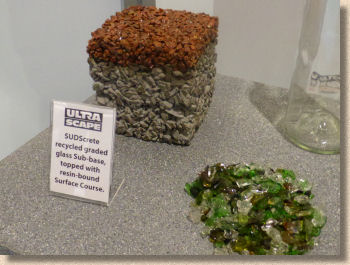
I suppose it all boils down to whether the usual purchasers of tree pit surfacing, which tends to be local authorities, can be persuaded to switch from their current ad-hoc methodology to the convenience of buying a bag-based solution, and that will very much depend on their own in-house bean counters tell them what they *think* their existing practice costs.
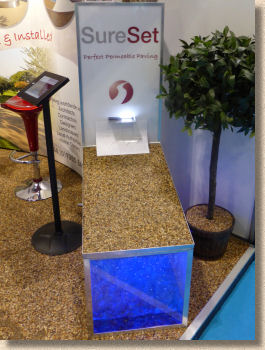
On the subject of resin bound surfacing, I spotted three such suppliers at the event, but given the enormity of the place, there may have been more that I missed amidst the taps, insulation and window frames. One spouted nonsense to me some years back, so I don't bother with them - I have neither the time nor the patience to listen to brazen bullshit - but I always have time for SureSet and AddaGrip.
SureSet have a clever display prop showing just how leaky is their surfacing, a perspex box with a cross-section of SureSet Permeable Surfacing which is being constantly rained upon, the water trickling thorugh with ease to be gathered up and recycled as yet more rain, and so the loop continues.
Addagrip , of course, have similar products, but they were showing two new products worthy of a mention. The Terrabound is a more cost-conscious resin bound surfacing, relying on a cheaper binder to render the whole package more affordable. The cost saving comes from the fact that the resin is slightly darker than normal, so isn't best suited to the paler aggregates, but more worryingly, it's not UV stable. I'm sure there will be a market for shorter lifespan, lower price decorative surfaces, but unless there's a significant cost saving, I can't see it being very big.
However, the second new product, which is so new that it doesn't really exist just yet, most definitely does have potential. MK Glass a self-binding aggregate which uses, you guessed it, crushed glass as a key component of the binder. It's worked well in France, and has seriously impressed the upper echelons of Addagrip, sufficiently enough to convince them to bring over a couple of tres jolie mademoiselles to help explain it to the assembled Ros Bifs.
It looks like a fine-aggregate, limestone-based concrete, and there are a selection of blends incorporating different aggregates, including recycled materials, which offer a range of finished appearances. The comparison with a concrete is valid, because it is mixed in much the same way, and needs to be laid using a paver machine for best results.
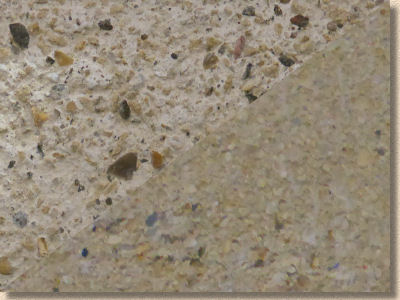
From the stats for this website, I know just how much interest there is in self-binding aggregates as a lower-cost, eco-ish friendly surafcing, but it's always seemed that the limiting factor has always been the paucity of supply. Given the continuing fascination with the godawful 'hoggin' in south and south-eastern England, this is a product with serious potential, and of all the new products seen at EcoBuild, this is the one that excites me most. With the right development and promotion, there's a highly promising future for it....whatever they call it!
Elsewhere, there were what we might think of as 'new' products but which are actually just clever tweaks and re-imaginings of existing products.
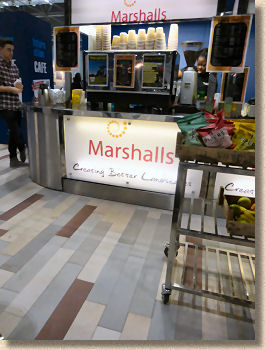
I was enormously privileged to be afforded a sneak preview of the StoneSpar from Marshalls when I was on a mercy mission in their Yorkshire homeland last month, and I was mightily impressed. For EcoBuild, they had used the high quality stone 'planks' to cover the floor of the cafe in the South Hall, wherein plied poor, unsuspecting victims with near lethal doses of deadly sugar in return for a tweet to the effect that the stone was most delightful. I was able to resist the glucose-based poisons thanks to filling up beforehand with non-toxic (on that day at least, according to certain health-and-Lady-Di-obsessed tabloids) pig-based snacks and so am capable of reporting that the general reaction to the various 'blends' of 600x130x65mm planks of better-than-average Indian sandstone was highly favourable.
Obviously, the degree of success depends on the mix of stones used to create the 'blend', but talking with other visitors both during and after the show, there was a rough0-and-ready agreement that the deep red Modak stone will not find favour in Lower Britain and is better suited to the industrial north of England, and up as far as the Midland Valley of Scotland, while the paler, more pastel tones will probably fare better in the benighted lands around that London.

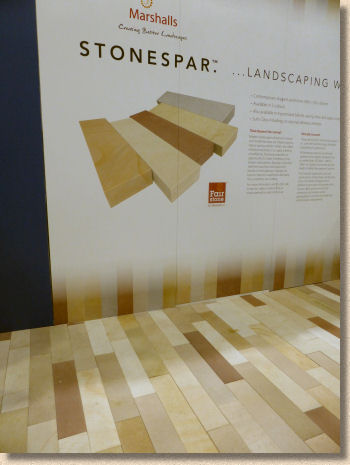
Having to cope with a gobshite like me in full mocking and sneering mode is probably the worst start imaginable to a career with the marketing department at Marshalls, so credit should go to the young ladies who kept smiling throughout my visit despite understanding little of my ramblings and references to the dark ages before 2010. I was very taken with the 'app' that's been developed to promote the StoneSpar and other 'blends' of stone, notably the manifold granites now being used to re-scape our town and city centres.
StoneSpar itself has enormous potential. What was on show last week is just a taster of the possibilities. Anyone with an eye for paving can see where all this can lead, how it can develop, the versatility it offers. While Marshalls might well be planning for its future in the commercial sector, I feel there is a possible market in the residential market. Homeowners are keenly scanning around for something a little different, but with class and understated taste. StoneSpar in a slimmer form may well be just the thing for them.
The second "almost new" products is a new brand of concrete block pavers from the innovative Belgian manufacturer, Schellevis . Well, they are new to Britain, but over on the western edge of mainland Europe, they are widely known, and highly respected for their strong colours and comprehensive range of sizes. I first saw these basalt textured concrete block pavers (CBPs) around 3 years ago when the family behind the business came to visit me in Warrington to discuss the potential of the British market and our strangely narrow appetite for CBPs, so to see that original idea develop and now launch itself is quite exciting.
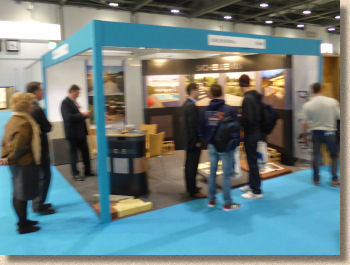
All of a sudden, the available palette for CBP and pavement design is significantly expanded because Schellevis bring us a new range of sizes, from the slim 150x50mm 'small pavers' (70mm deep!) to the bloody impressive 1000 x 1000 x 50mm (yes, just 50mm!) mega tegels in the full range of colours, and, if you're impressed by size, how about a 2400 x1200mmm beast at 120mm thick and weighing in at a ball-busting 770kg. There's a lot more, of course, but it's the exciting ability to include European aesthetics in our designs which should really stir your interest.
Their initial efforts will, unsurprisingly, focus on Lower Britain, particularly the south-east corner of England purely because of logistics, but they do want to provide a nationwide offer. Many European CBP manufacturers have toyed with the British market over the years, but none have had any lasting impact. I think Schellevis could break that depressing cycle because they are bringing a product range which has a strong appeal to garden designers and landscape architects, a sector of our industry with a slightly more open mind than that normally found with civic and commercial streetscape designers.
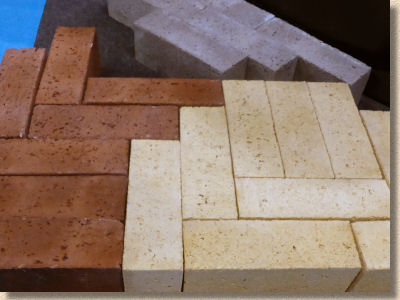
And speaking of Belgian paving, the natural stone of that country, known throughout the world as 'Belgian Blue Stone', should be a lot easier to acquire now that Trans European Stone have set up a dedicated supply service bringing Pierre Bleue into Blighty. I've never really understood why the ice-cool blue limestone, which is widely used across Europe and beyond, has been so scarce in Britain, when there's only 35 miles or so of briny sea between the nations. Slightly different story in Ireland, which is not exactly short of its own blue limestone, but the relative paucity of Belgian Blue amongst the plethora of stone we now use on our streets and in our gardens, is a shameful oversight.
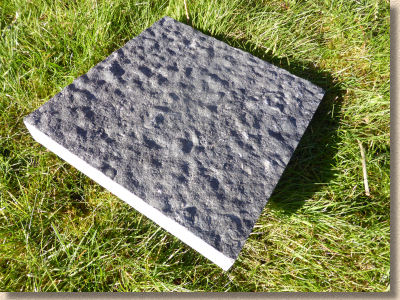
There are some very interesting textures available, too. While bluestone is usually seen in a honed finish for internal use or bush-hammered for outdoors, Pierre Bleue offer a subtle flamed finish and a very intriguing….well, I don't quite know what to call it, a sort of turbid texture which looks fantastic in natural light with the interplay of the shadows across the distinctively tactile surface. They call it Vieux Soignies, which I can't even pronounce, so I'll just call it Lumpy-Bumpy, which I believe has a definite Gallic/Walloon ring to it.
On the subject of national stone, a West Country outfit with the oh-so-English sounding name of Artorius Faber , have stepped out of their comfort zone of high-end stone flooring to bring us what they are hoping will be one of the most comprehensive platter of British Stone Paving available from a single source.
They certainly have some lovely stone on show, but I have reservations regarding the suitability of some of it as paving for high traffic areas. Portland is a lovely building stone, and I know certain specific beds do provide some stone that gets used for paving in and around Salisbury, but much of it is far better employed as ashlar masonry for grand architecture. The same can be said of many of the Old Red Sandstones of western Britain.
However, in this age of endless imports from ever further flung locations, it is genuinely good to see a business devoting itself to native stone. We should never forget that these islands are blessed with some of the finest building and paving stone available anywhere on the planet. It can be pricey, because we are not a so-called developing nation, but I would love to see more of our own stone used to re-scape some of our towns and cities. It's what makes each region distinctive. If all our urban centres fall for the easy/cheap option of a 4 colour blend of Chinese granite laid transverse broken bond, then that's another step towards the hell of identikit High Streets. If Artorius can help retain a bit of the native character, then that's no bad thing.
But I still can't figure out why their impressively lavish brochure smells like a stale ashtray!
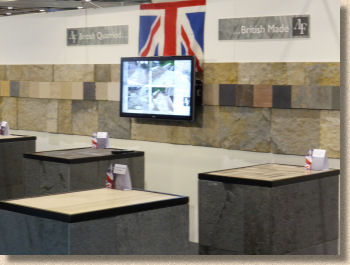
Naturally, there's much that I haven't mentioned, the useful, the interesting, the different, the strange, and the plain bleeding doolally, without which it wouldn't be EcoBuild. Plenty of rainwater harvesting (just in case we ever run short of the damned stuff – good luck selling that idea in Somerset!), and a dash of storm crates, but not as much as there should be. Student types loafing about on bean-bags inside a den made from cardboard hexagons watching some eco-bollocks on a big telly, plenty of over-perfumed sales-bods trying to impress you with apps to change the world, and strange erections built from what looked like giant lollysticks.
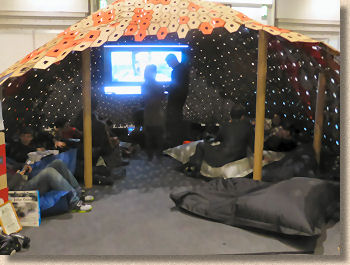
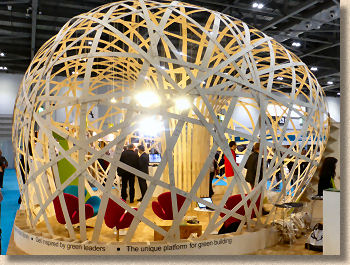
EcoBuild has become the default event for the construction industry and yet managed to retain its green-ish credentials. That's no mean feat. It has its shortcomings, not least of which is the completely haphazard distribution of paving and drainage exhibitors, and it desperately needs a BIG NAME paving manufacturer or distributor to give it more credibility, but even so, it's still just about the most relevant show we have for now (mainly because there's buggerall in the way of competition). It continues to perform that balancing act of providing just a morsel more than the statutory minimum necessary to tempt me down from the north, and so I keep going.


